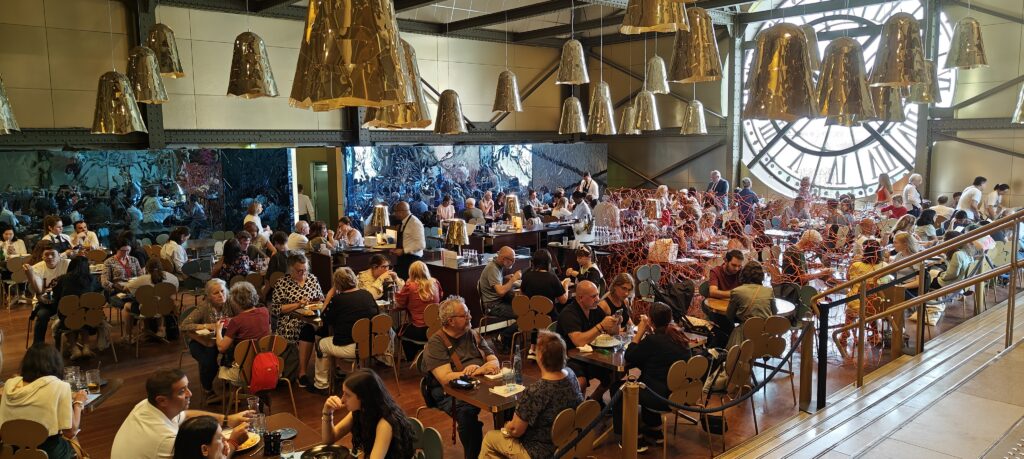Paris, the City of Light, cradles countless treasures, but nestled elegantly along the Left Bank of the Seine, housed within the breathtaking skeleton of a former Beaux-Arts railway station, lies my absolute favourite museum in the entire world: the Musée d’Orsay. Having had the profound privilege of walking its luminous halls not once, but twice, I can attest that its magic only deepens with each visit. This isn’t merely a repository of art; it’s a transformative experience, a portal directly into the heart of the most revolutionary artistic period of the modern era, spanning roughly from 1848 to the dawn of the First World War in 1914. For anyone whose soul stirs at the sight of a masterfully captured play of light, a daring brushstroke, or the emotional resonance of sculpted form, the Orsay is not just a recommendation; it is an imperative pilgrimage.

What sets the Orsay apart, beyond its phenomenal collection, is its remarkably accessible scale. Unlike the overwhelming vastness of the Louvre, which can feel like navigating a continent, the Orsay possesses an intimate grandeur. Its layout, intuitively structured within the former station’s framework, is surprisingly easy to navigate. You won’t find yourself lost for hours in labyrinthine corridors. Instead, the chronological flow, guiding you through the seismic shifts from Academicism and Realism to the explosive birth of Impressionism, Post-Impressionism, and Symbolism, feels natural and unhurried. This manageable size allows for genuine contemplation, letting you absorb the genius before you without the fatigue that often accompanies larger institutions. You can truly see the art here.
A Cathedral of Iron and Light: The Gare d’Orsay Reborn
To fully appreciate the Orsay, one must understand its remarkable genesis. Its very walls whisper a history that predates its current incarnation. Imagine the scene at the turn of the 20th century: the magnificent Gare d’Orsay, designed by the visionary architect Victor Laloux, opened its doors in 1900, perfectly timed for the Paris Exposition Universelle. Laloux masterfully concealed the station’s modern iron structure – a marvel of the industrial age – behind an opulent, impeccably detailed Beaux-Arts facade of stone. This grand terminus, with its soaring vaulted glass ceiling bathing the concourse in ethereal light, was the epitome of Parisian elegance and technological prowess, welcoming travellers from across France.
Yet, progress waits for no one. By 1939, the station’s platforms were too short for the new, longer trains of the burgeoning electric era. The Gare d’Orsay fell silent, its echoing halls destined for decades of neglect, serving only intermittently as a mailing centre, a theatre set, and even a refuge auction house during the turbulent years of the German Occupation. For a time, its fate hung precariously in the balance, threatened with demolition. Thankfully, in the 1970s, amidst a growing appreciation for preserving France’s industrial heritage, a bold vision emerged: transform this architectural masterpiece into a museum dedicated to the very art produced during its operational lifetime. The decision, formalized in 1977, sparked an ambitious five-year renovation. Architects Renaud Bardon, Pierre Colboc, and Jean-Paul Philippon faced the monumental task of respecting Laloux’s original vision while creating functional, modern gallery spaces within the station’s unique skeleton. Their triumph was unveiled on December 1st, 1986, inaugurated by the legendary jazz musician Miles Davis – a fittingly innovative beginning for a museum celebrating artistic revolution. Stepping inside today is to walk into a sublime marriage of 19th-century ambition and 20th-century museology, where the building itself is the first and most powerful exhibit.
A Chronological Tapestry of Artistic Revolution: The Collections Unveiled
The Musée d’Orsay’s brilliance lies not just in what it holds, but how it presents it. Eschewing a strict focus on individual artists, the collections are thoughtfully organized chronologically by artistic movement. This curatorial decision is revelatory. It allows you to witness, step-by-step, the evolution of ideas, the rebellions against established norms, and the cross-pollination of styles that defined this incredibly fertile period. You don’t just see paintings and sculptures; you experience the unfolding narrative of modern art.
- The Grand Narrative Begins: Painting the 19th Century: The painting collection is, quite simply, staggering. It begins with the monumental Academic works and the penetrating gaze of Realism (think Courbet’s imposing “The Artist’s Studio” or Millet’s poignant depictions of rural life), setting the stage against which the rebels would soon push. Then comes the seismic shift: Impressionism. Here, the air itself seems to shimmer. Claude Monet’s studies of light on water, haystacks, and his iconic cathedral facades capture fleeting moments with breathtaking poetry. Pierre-Auguste Renoir’s scenes of joyous leisure, dappled with sunlight and vibrant colour, radiate warmth. Camille Pissarro, the gentle patriarch, offers views of Paris and the countryside with profound sensitivity. Berthe Morisot, a vital female voice within the movement, brings an intimate, fluid touch to domestic scenes and portraits. Édouard Manet, the pivotal figure who bridged Realism and Impressionism, challenges conventions with works like the provocative “Olympia” and the revolutionary “Luncheon on the Grass.”
Moving beyond the pure light chase, the Post-Impressionists explode onto the scene. This is where Vincent van Gogh’s emotional torrent finds its form. Standing before the swirling, cobalt depths of “Starry Night Over the Rhône” or the intense, almost vibrating colours of his “Self-Portrait” or the “Church at Auvers” is an encounter that resonates deep within the soul. His raw energy is palpable. Alongside him, Paul Cézanne lays the foundations of Cubism with his geometric explorations of form in works like “The Card Players” and his monumental Mont Sainte-Victoire series. Paul Gauguin transports us to Tahiti with his symbolic, boldly coloured canvases seeking a primal paradise. Georges Seurat meticulously constructs shimmering worlds of pure colour using Pointillism (“The Circus”). Henri de Toulouse-Lautrec captures the electric, sometimes decadent, pulse of Montmartre nightlife with incisive line and dramatic composition. This section alone demands hours of contemplation.
- Form in Flux: The Sculpture Collection: Often underappreciated but equally magnificent, the sculpture collection at the Orsay is a journey through three-dimensional innovation. It powerfully demonstrates how sculptors grappled with the same themes of modernity, realism, movement, and expression as their painter counterparts. The galleries showcase a stunning array, from the allegorical grandeur of Academic pieces to the radical naturalism of Jean-Baptiste Carpeaux (“Ugolino and His Sons”). The undeniable titan here is Auguste Rodin. His “The Gates of Hell,” a monumental, swirling tempest of figures, dominates one space, while iconic works like “The Thinker,” “The Kiss,” and the profoundly moving “The Burghers of Calais” reveal his unparalleled ability to capture raw human emotion and psychological depth in bronze and marble. The tragic genius of Camille Claudel, Rodin’s pupil, lover, and formidable artistic rival, is finally receiving its due recognition here, with powerful works like “The Waltz” and “The Mature Age” showcasing her intense narrative power and technical mastery. Edgar Degas, primarily known as a painter, reveals another facet of his genius with his intimate, dynamic bronze sculptures of dancers and bathers, capturing fleeting moments of grace and exertion. The sculptures are thoughtfully integrated throughout the museum, often in dialogue with paintings of the same period, enriching the understanding of the era’s artistic dialogue.
- The Art of Living: The Decorative Arts Collection: To fully grasp the 19th-century aesthetic spirit, one must look beyond the canvas and the plinth. The Orsay’s extensive decorative arts collection provides this essential context. It’s a treasure trove of exquisite craftsmanship and evolving design philosophies. Wander through recreated period rooms showcasing sumptuous Art Nouveau interiors by masters like Hector Guimard (famous for his Paris Metro entrances) and Émile Gallé, where organic forms, sinuous lines, and exquisite glasswork create immersive environments. Discover the intricate furniture, shimmering glassware, intricate jewellery, and diverse objets d’art that graced the homes of the burgeoning bourgeoisie and avant-garde patrons. This collection traces the fascinating trajectory from the historicism of the Second Empire through the naturalistic exuberance of Art Nouveau to the emerging geometric clarity that would blossom into Art Deco. It reminds us that the artistic revolution permeated every facet of life.
Architectural Icons and Lavish Interiors: Experiencing the Space
Laloux’s original Beaux-Arts structure provides an awe-inspiring setting. The central nave, once the bustling train concourse, remains the museum’s breathtaking heart. Soaring 32 meters high, its magnificent arched glass roof bathes the entire space in a luminous, ever-changing natural light – the perfect illumination for the Impressionist works that celebrate light itself. Walking beneath this canopy, with sculptures strategically placed along the central aisle, is an experience unlike any other museum visit. It feels cathedral-like, inspiring quiet reverence.
But amidst this grandeur, certain features leave an indelible personal mark. For me, the giant station clock, a monumental relic from the Gare d’Orsay’s past, was a profound thrill. Encased in its ornate gilded frame, its massive glass face isn’t merely a timepiece; it’s a breathtaking window offering a panoramic vista of Paris. Standing before it, looking out towards the Seine, Montmartre crowned by the Sacré-Cœur, and the distant sprawl of the city, is a moment suspended between the artistic past within and the living city outside. It’s a powerful, almost cinematic, punctuation point within the museum experience.
Furthermore, the Orsay understands that art appreciation is a full-sensory journey. Refueling is essential, and they offer not just sustenance, but an experience. The museum houses several cafes and restaurants, but the undisputed jewel is the Restaurant du Musée d’Orsay. Housed within the station’s original, incredibly opulent first-class dining room, designed by Laloux himself, stepping inside feels like travelling back to the Belle Époque. Soaring ceilings adorned with elaborate gilded stuccowork and breathtaking chandeliers, monumental mirrors, and sumptuous period details create an atmosphere of palpable lavishness. Enjoying a coffee, lunch, or afternoon tea beneath these chandeliers, surrounded by such historical opulence, is not merely a break; it’s an extension of the artistic immersion, a chance to dine within a living work of art. It provides a moment of luxurious respite, allowing you to reflect on the wonders you’ve witnessed.

Crafting Your Orsay Experience: Essential Wisdom for the Discerning Visitor
The Musée d’Orsay’s immense popularity is well-deserved, attracting millions of art lovers annually. To ensure your visit is as seamless and enriching as mine were, heed this crucial advice born from experience:
- The Golden Rule: Book Tickets in Advance: This cannot be overstated. Purchasing your tickets online, well before your intended visit date, is absolutely paramount. The official Musée d’Orsay website offers timed entry slots. Securing your place electronically dramatically speeds up the process. You bypass the notoriously long queues snaking along the Seine and walk directly to the entrance for visitors with pre-booked tickets (clearly signposted). The difference is measured in hours, not minutes. While it is theoretically possible to buy tickets at the door, especially during off-peak seasons or weekdays, this is a gamble fraught with potential for significant disappointment. The queues can be soul-crushingly long, easily stretching to two or three hours during peak times (spring, summer, weekends, holidays). Don’t sacrifice precious exploration time standing outside. Book ahead.
- Timing is Everything: The museum opens daily at 9:30 AM. Arriving at opening time, especially with a pre-booked ticket, grants you the precious gift of relative tranquility in the galleries before the crowds fully descend. Thursday evenings offer extended hours until 9:45 PM, often accompanied by a slightly quieter, more atmospheric experience, particularly later in the evening. Weekdays are generally less crowded than weekends.
- Enhancing Your Understanding: While the art speaks powerfully on its own, context enriches the experience exponentially. The museum offers excellent audioguides available in multiple languages. These provide insightful commentary on key works, artists, and movements, adding layers of understanding you might otherwise miss. For a deeper dive, consider researching specific artists or movements beforehand, or even joining one of the museum’s guided tours (check the website for schedules and languages).
- Planning Your Route: Given the chronological layout, starting on the ground floor (lower level) with the early Academic and Realist works, then moving up through the Impressionist galleries on the middle level, and culminating with the Post-Impressionists and Symbolists on the upper levels, is a logical and rewarding progression. However, don’t feel enslaved by chronology! If your heart pulls you immediately to the Van Goghs or Monets, head there first. The manageable size makes circling back easy.
- Beyond the Physical Walls: For those unable to make the journey to Paris, or for visitors wanting to preview the collections, the Musée d’Orsay offers a comprehensive virtual tour on its website. This digital exploration allows you to navigate the galleries and view high-resolution images of many key works. It’s a valuable resource, though it naturally pales beside the visceral impact of standing before the originals.
- Engaging Young Minds: The museum thoughtfully caters to younger visitors with engaging workshops and activities designed for children aged six and above. These interactive programs introduce kids to art concepts and the museum’s collections in fun and accessible ways, planting the seeds for future art appreciation.
A Sanctuary Revisited: The Enduring Allure
My two journeys through the Musée d’Orsay were not merely visits; they were profound encounters. The first was a revelation, the second a deeper communion. What cements its status as my favourite museum in the world is the unparalleled convergence it achieves: the breathtaking Beaux-Arts architecture of the Gare d’Orsay, reborn as a perfect vessel; the manageable, navigable scale that fosters intimacy with the art; and, above all, the unrivaled concentration of masterpieces from the most thrillingly innovative period in Western art history. To stand enveloped by the vibrant hues of the Impressionists, to feel the emotional intensity radiating from Van Gogh’s canvases, to contemplate Rodin’s monumental figures, all beneath that magnificent glass vault – this is an experience that transcends mere viewing. It’s a dialogue across time, a celebration of human vision and daring.
The Musée d’Orsay is more than a museum; it’s a sanctuary for the senses and the spirit. It’s a place where the revolutionary spirit of 19th-century art feels vibrantly alive, housed within a monument to 19th-century ambition. It offers not just art history, but an enduring sense of wonder. From the practical thrill of bypassing queues with a pre-booked ticket, to the awe inspired by the giant clock’s panorama, to the quiet contemplation before a Monet water lily or a Van Gogh starry sky, to the Belle Époque grandeur of its dining room, every facet contributes to an experience that lingers long after you depart. It is, without reservation, a masterpiece containing masterpieces, and it awaits your own journey of discovery. Prepare to be enchanted, challenged, and utterly captivated.






